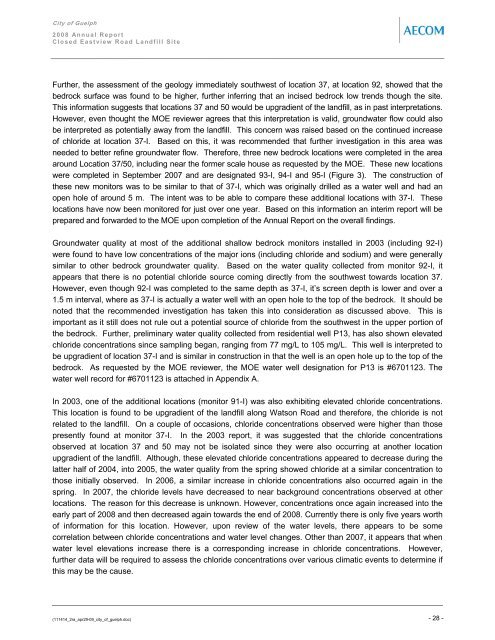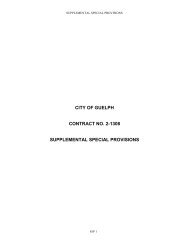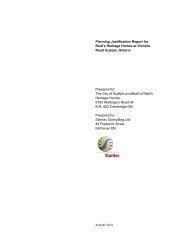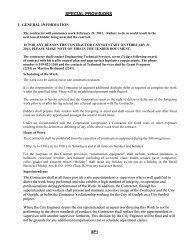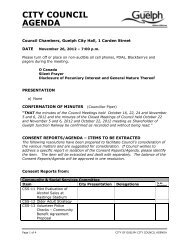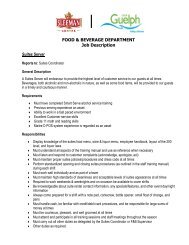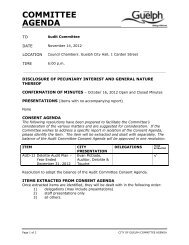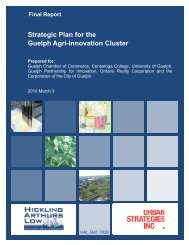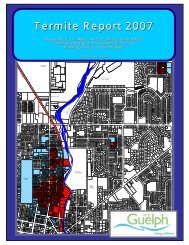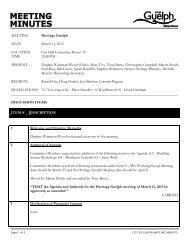AECOM Report B&W - N - City of Guelph
AECOM Report B&W - N - City of Guelph
AECOM Report B&W - N - City of Guelph
Create successful ePaper yourself
Turn your PDF publications into a flip-book with our unique Google optimized e-Paper software.
<strong>City</strong> <strong>of</strong> <strong>Guelph</strong>2008 Annual <strong>Report</strong>Closed Eastview Road Landfill SiteFurther, the assessment <strong>of</strong> the geology immediately southwest <strong>of</strong> location 37, at location 92, showed that thebedrock surface was found to be higher, further inferring that an incised bedrock low trends though the site.This information suggests that locations 37 and 50 would be upgradient <strong>of</strong> the landfill, as in past interpretations.However, even thought the MOE reviewer agrees that this interpretation is valid, groundwater flow could alsobe interpreted as potentially away from the landfill. This concern was raised based on the continued increase<strong>of</strong> chloride at location 37-I. Based on this, it was recommended that further investigation in this area wasneeded to better refine groundwater flow. Therefore, three new bedrock locations were completed in the areaaround Location 37/50, including near the former scale house as requested by the MOE. These new locationswere completed in September 2007 and are designated 93-I, 94-I and 95-I (Figure 3). The construction <strong>of</strong>these new monitors was to be similar to that <strong>of</strong> 37-I, which was originally drilled as a water well and had anopen hole <strong>of</strong> around 5 m. The intent was to be able to compare these additional locations with 37-I. Theselocations have now been monitored for just over one year. Based on this information an interim report will beprepared and forwarded to the MOE upon completion <strong>of</strong> the Annual <strong>Report</strong> on the overall findings.Groundwater quality at most <strong>of</strong> the additional shallow bedrock monitors installed in 2003 (including 92-I)were found to have low concentrations <strong>of</strong> the major ions (including chloride and sodium) and were generallysimilar to other bedrock groundwater quality. Based on the water quality collected from monitor 92-I, itappears that there is no potential chloride source coming directly from the southwest towards location 37.However, even though 92-I was completed to the same depth as 37-I, it’s screen depth is lower and over a1.5 m interval, where as 37-I is actually a water well with an open hole to the top <strong>of</strong> the bedrock. It should benoted that the recommended investigation has taken this into consideration as discussed above. This isimportant as it still does not rule out a potential source <strong>of</strong> chloride from the southwest in the upper portion <strong>of</strong>the bedrock. Further, preliminary water quality collected from residential well P13, has also shown elevatedchloride concentrations since sampling began, ranging from 77 mg/L to 105 mg/L. This well is interpreted tobe upgradient <strong>of</strong> location 37-I and is similar in construction in that the well is an open hole up to the top <strong>of</strong> thebedrock. As requested by the MOE reviewer, the MOE water well designation for P13 is #6701123. Thewater well record for #6701123 is attached in Appendix A.In 2003, one <strong>of</strong> the additional locations (monitor 91-I) was also exhibiting elevated chloride concentrations.This location is found to be upgradient <strong>of</strong> the landfill along Watson Road and therefore, the chloride is notrelated to the landfill. On a couple <strong>of</strong> occasions, chloride concentrations observed were higher than thosepresently found at monitor 37-I. In the 2003 report, it was suggested that the chloride concentrationsobserved at location 37 and 50 may not be isolated since they were also occurring at another locationupgradient <strong>of</strong> the landfill. Although, these elevated chloride concentrations appeared to decrease during thelatter half <strong>of</strong> 2004, into 2005, the water quality from the spring showed chloride at a similar concentration tothose initially observed. In 2006, a similar increase in chloride concentrations also occurred again in thespring. In 2007, the chloride levels have decreased to near background concentrations observed at otherlocations. The reason for this decrease is unknown. However, concentrations once again increased into theearly part <strong>of</strong> 2008 and then decreased again towards the end <strong>of</strong> 2008. Currently there is only five years worth<strong>of</strong> information for this location. However, upon review <strong>of</strong> the water levels, there appears to be somecorrelation between chloride concentrations and water level changes. Other than 2007, it appears that whenwater level elevations increase there is a corresponding increase in chloride concentrations. However,further data will be required to assess the chloride concentrations over various climatic events to determine ifthis may be the cause.(111414_2ra_apr29-09_city_<strong>of</strong>_guelph.doc) - 28 -


